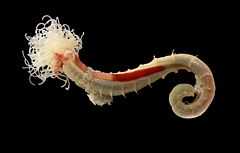Terebellidae
| Terebellidae | |
|---|---|
 | |
| Lanice conchilega (Terebellinae), taken out of its burrow. Note "spaghetti" tentacles on head. | |
| Scientific classification | |
| Kingdom: | Animalia |
| Phylum: | Annelida |
| Class: | Polychaeta |
| Subclass: | Palpata |
| Order: | Canalipalpata |
| Suborder: | Terebellida |
| Family: | Terebellidae Grube, 1851 |
| Subfamilies | |
|
4, see text | |
Terebellidae is a family of polychaete worms. They are surface deposit feeders, catching falling particles with numerous elongate prostomial tentacles splayed out on the sea floor. These tentacles, which are the most or only normally visible portion of the animal and are reminiscent of spaghetti, inspired the common name spaghetti worms. The remainder of the animal is in a semi-permanent burrow or permanent tube in soft substrates.
Most terebellids live in burrows or crevices and are often of large size, ranging up to 150 millimetres in length and 15 millimetres in width. The numerous, very long tentacles which radiate from near the mouth are used for finding and collecting food particles from the sediment surface. The tentacles are not retractable as is the case in the ampharetids. They have plump anterior bodies and numerous segments in their long, tapered posterior bodies, whereas ampharetids are more compact. They have branched gills laterally on up to three anterior chaetigers but in the subfamily Thelepodinae the gills are numerous simple filaments. The mid-body chaetigers are in double rows in the subfamily Terebellinae. In the subfamily Polycirrinae, the gills are absent and the prostomium is expanded as an undulating membrane which bears the tentacles.,[1][2]
Systematics
The roughly 400 known species are divided between many dozens of genera. Most of these are assigned to 4 subfamilies.[3] Some additional genera are of unresolved or quite basal position.
- Basal or incertae sedis
- Genus Amphitrite
- Genus Athelepus
- Genus Dendrobranchus
- Genus Ehlersiella
- Genus Morgana
- Genus Odysseus
- Genus Paraeupolymnia
- Genus Terebellodibranchia
- Genus Tyira
- Genus Uncinochaeta
- Subfamily Amphitritinae
- Subfamily Artacaminae
- Subfamily Polycirrinae
- Subfamily Thelepodinae
References
- ↑ Annelid resources
- ↑ http://www.marinespecies.org/aphia.php?p=taxdetails&id=322588 accessed 23 SEptember 2013
- ↑ World Register of Marine Species
See also
External links
| Wikispecies has information related to: Terebellidae |
| Wikimedia Commons has media related to Terebellidae. |